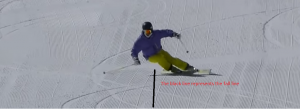See, here is the problem: it comes down to semantics. Whatever term you pick, it has all sorts of connotations that come along with it, and based on whatever perspective the listener comes from, their experience will influence how they interpret the term. The unfortunate part of that is that the intent of the term, which has all sorts of aspects relating to the duration, intensity, rate, and timing, are lost or muddled because the listener's frame of reference has influenced (co-opted?) their receptivity to the concept.
With that being said, here's my understanding of toppling, at least as described and advocated by Tom Gellie. The purpose of toppling is to maintain/establish the earliest pressure on the ski in the top of the turn. By releasing the upper body from it's arc prior to releasing the skis from theirs, the body can lead into the top of the turn. And if the release of the body is down the hill, rather than up and over, pressure on the outside ski will be earlier than if the body travels up and then down -- the up and down movement has to result in. a longer path of travel, so pressure will be later. Also, using the toppling transition results in a higher line with more options at the next gate.
Gellie has a lot of content on his website demonstrating toppling in World Cup athletes, including Mikeala, Hirscher, Robinson, etc. I suggest you take a look at it and see what you take away. It does us no good to argue over whether we like or dislike a term when no one is really talking about the complex mechanics that that term was intended to describe.
Mike

 Btw, that on snow toppling vid was ok in that respect. Maybe just keep his clothes on and be on snow?)
Btw, that on snow toppling vid was ok in that respect. Maybe just keep his clothes on and be on snow?)
